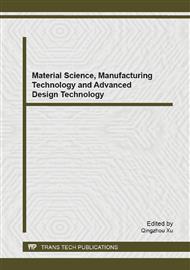p.217
p.222
p.228
p.232
p.236
p.241
p.249
p.253
p.259
Analysis of Stretching Load in Tension Stretching Process of Aluminum Alloy Thick-Plate by Using Finite Element Method
Abstract:
Tension stretching process is an important link in production of aluminum alloy thick-plate. Exploring the change of load in tension stretching process is important for the structure designing and key component checking of large-scale tension stretcher. In this paper, the changing law of stretching force in the tension stretching process of aluminum alloy 6063 thick-plate has been investigated by numerical simulation method, and the influence of initial thickness of plate and friction condition in clamping area was analyzed. The results indicated that the initial thickness has a notable influence but friction condition has a little influence on stretching load; and the stretching force increases at first and then decreases slightly, and then it is tending toward stability; and the larger the values of thickness and friction, the more stable the stretching force in the process.
Info:
Periodical:
Pages:
236-240
Citation:
Online since:
March 2014
Authors:
Price:
Сopyright:
© 2014 Trans Tech Publications Ltd. All Rights Reserved
Share:
Citation:


